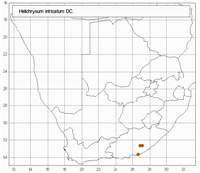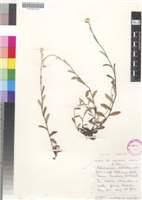Origin of name:
intricatus = entangled
Diagnostic characters:
Heads felted together into flat-topped inflorescences
Description:
Perennial herb with tufts of delicate wiry stems decumbent then erect, up to 600 mm long, virgate, glabrous below, white-woolly-felted above, leafy, becoming pedunculoid upwards. Leaves mostly 12�30 x 2.5�8 mm, diminishing upwards and passing into small distant bracts, oblong, oblong-spathulate or lanceolate, apex sub-acute or acute, mucronate, base cordate-clasping in larger leaves, margins slightly revolute, upper surface with coarse spreading hairs, cobwebby as well initially, lower surface white woolly-felted. Heads homogamous or heterogamous, campanulate, 4 x 2.5 mm, many felted at the base into terminal flat-topped glomerules 10�20 mm across, becoming somewhat looser with age. Involucral bracts in 4 series, graded, loosely imbricate, outermost pale brown or yellow, webbed together with wool, inner lemon-yellow, sub-pellucid, tips obtuse, about equaling flowers, minutely radiating. Receptacle with fimbrils about equaling or exceeding ovaries. Flowers 8�15, 0�3 female, 6�15 homogamous. Achenes 1 mm long, broadly cylindric, glabrous or with myxogenic duplex hairs. Pappus bristles many, equaling corolla, scabrid, bases cohering by patent cilia, some light fusion as well.
Flowering in December and January.
Distribution:
Recorded from 'between Swellendam and George', Van Staadensberg (Dr�ge), 'Groote Hoogte and Assagai Bosch' (Pappe), then Hogsback, Katberg, Thomas Mountain and Evelyn Valley near Stutterheim. Grows in marshy places, forming large tangled masses at the muddy margins of streams or in the sponges at their sources.Thicket Biome.
Notes:
In the type collection and that made by Pappe the heads contain 1-3 female flowers and the achenes are hairy; the specimens from Hogsback, Katberg, and Evelyn Valley have homogamous heads and glabrous ovaries, but no other feature to distinguish them was observed. The species is rarely collected, and should be sought between Swellendam and the Amatola Mountains so that its variability can be properly assessed.
Taxonomy:
Literature:
Helichrysum intricatum DC., Prodr. 6: 204 (1838); Harv. in F.C.3: 248 (1865).
Type:
Western Cape, between Swellendam and George, Ecklon 299 (G-DC, holo.; S, iso.).
Synonym(s):
Gnaphalium intricatum (DC.) Sch. Bip. in Bot. Ztg 3:172 (1845).
Helichrysum anomalum var. lanatum DC., Prodr. 6: 204 (1838), nomen. Van Staadensberg, 1 000�2 000 Fuss, Dr�ge (distributed as H. anomalum var. lanata DC. a, BM; G).
Vouchers:
Compton 19268, 19142 (NBG); Hilliard & Burtt 10987 (E; K; M; MO; NU; PRE; S); Leighton 2717 (BOL; K; NBG); Pappe s.n. (SAM; TCD).


